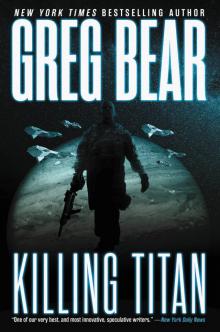Ares Rising 1: War Dogs Read online
Page 11
Latecomers? Stragglers? Male and female needs transvac are sufficiently different that we often ride different sticks and join into combat-ready units in theater, on the Red.
Teal zooms in without my asking, and I manage to scan their blazes: U.S. Seventh Marines on one, ISD Second Interplanetary on the other two. I make out three flags: U.S., of course, and—among our favorite allies on the Red—Malaysian and Filipino.
From the other buggies, six more Skyrines descend, also female and heavily armed. Between them, I count four flechette guns, two armor-punching lasers, and a microwave disruptor, effective against Antag equipment in past engagements, but according to recent tech skinny, maybe no more. The last to step down from the point buggy is a Filipino gunnery sergeant, and she hefts a strong-field suppressor, about as big and impressive a weapon as any one of us can carry.
Teal sweeps over to a captain’s parallel bars, and a stenciled name well known to me: Daniella Coyle. Captain Danny Coyle. I barely suppress a whoop. “Holy shit,” I say. “Sisterhood is powerful!”
Teal is puzzled by my triumph. “T’ey’re yours?” she asks.
“I am theirs,” I say. “Outlaw ladies held up the Dodge stage. Time to make them welcome!”
BACKGROUNDER, PART 2
Now is not the time to get into all the branches and divisions and shit, but while we’re watching more internationals and ladies arrive on our scene, light ’splainin’ is in order.
International Sky Defense (ISD) is our overarching authority. Its symbol is a flaming shield protecting a speckled blue marble, Earth, kind of like SHAEF but spacey. At its highest level, ISD Joint Command is staffed by politicians and retired military commanders from all signatory nations. Joint Command, everyone assumes—but no one I’ve met actually knows—reports to the Wait Staff, representatives of the Gurus.
Below Joint Command, each signatory nation assigns warriors and resources and helps pay for ISD’s orbital assets, transfer craft—space frames, sleds, and such—and weapons, including R&D.
The United States “loans” Navy, Marine, Air Force, and Army warriors to ISD. Other countries assign, we loan; same difference. Skyrines sometimes combine not just with international units, but with other U.S. services, mostly Army or Air Force—and since we’re already under NAVSEC, the secretary of the Navy, and he’s mostly obedient to Joint Command, that means we can run into warriors from just about any branch of service, and any signatory nation, recognize them more or less as partners, try hard to respect their command hierarchy, and work together efficiently, mostly without invoking esprit de corps, which can make Marines pugnacious.
Historically, that’s how we see ourselves—Skyrines are nothing more nor less than Marines who ride rockets. Some say we’re a touch more civilized than ground pounders, but frankly, I don’t see or feel that, and once all the battles are won and the Antags have fled back across the sea of stars, we will happily revert to the well-trained, tightly disciplined, rudely judgmental bastards we have always been.
Even with all that, when we’re off the field of battle and engaging in additional training or just plain R&R, we manage to get into some lovely threaps—that is, swedges, stoushes, dustups, squash-downs, knucklers, blennies, bruisers, fwappers, scratchers, jawbusts, jointers, joists, jaunts, jousts, teethers, chirps, flips, funsies, fisticuffs, ball-tug, dentals, gouges, or, in more common parlance, disagreements, tête-à-têtes, contretemps—fights.
Eskimos = twenty words for snow. Skyrines = twenty-plus phrases for getting scrappy, in that friendly sort of way where we rarely kill each other.
If you don’t understand where fights will begin, and who is going to be on your side, and who is just not, you can get into trouble fast. Among the ISD signatories, U.S. Marines buddy up well with Filipinos, Koreans, Japanese, the few Guamanians we run into, Fijians (Pacific Islanders in general), New Zealanders (especially Maoris), and Australians. We get along okay with Brits and the French. The Italians have wine and MREs to die for and the most beautiful women I’ve ever seen in space, except for all the rest. We love the Indians and Pakistanis and Sri Lankans and Tibetans, and of course, there’s Kazak and the ’stans, good people all.
Skyrines mostly get along with the Chinese, but we can have issues with Russians, though both are terrific at the beginning of a drunk and downright fierce on the Red.
Canada, Germany, Austria, Spain, most of Eastern Europe, all of South America, and Africa—but for Somalia, Ethiopia, and Yemen—are not signatory.
WHILE TRAINING AT Hawthorne, we used our one day of R&R to visit Lindy’s 1881, a rough local bar in the small, square desert town. There, by severe happenstance, we met up with a stack of eleven Russian exchange officers. They had been invited to Hawthorne to lecture and critique U.S. training practices. What numbnuts depot clerk let them out all at once to do the town has never been revealed.
The encounter started off jovial. The Russians tried to explain, over beer and cold peppered vodka, how training at Socotra—off the tip of Yemen—and in Siberia was so much harsher and more realistic than anything we went through here at Hawthorne. Kazak disagreed and gave them the stink-eye. His people and theirs have history. It was obvious words would soon lead to deeds. After a few minutes of verbal give-and-take, Tak, Kazak, Michelin, myself, and four female Skyrines conferred how best to deploy a Fist Marine Division.
One of those sisters was then–First Lieutenant Coyle, chaperoning her brood and standing aloof from us grunts, but nodding to the music and enjoying the ambience—until she saw she could not get her chicks out fast enough to avoid the coming scuffle.
The sisters walked between their brothers and formed a loose line between them and the Russians. This encouraged the Russians to smirk and question our masculine courage. They gave each other encouraging looks and foresaw easy mayhem followed by another round of cold vodka.
The locals, a crusty, paunchy crew, well past their middle years, cleared chairs and tables and sat by with big grins.
Meanwhile, Michelin casually took post by the bar’s rear exit.
The Russians led with three burly toughs. At a barely perceptible nod from Coyle, the sisters withered and allowed their line to dimple, then to break up. Brothers and sisters re-formed into flanks on both sides of the long bar, opening up space at the side of the establishment for our rear echelons to maneuver.
And so we did.
The Russians, no strangers to bar fights, observed these tactics through a vodka haze and finally recognized the seriousness of their plight. Smirks turned to frowns.
Kazak, with a wink at Tak and me, said something very offensive.
Game on.
Our Russian allies whipped out a steel grove of navy-issue Iglas—wickedly practical blades—and, from puffy pant legs, slowly pulled knotted climbing ropes and lengths of tow chain. Brows furrowed, knuckles white, balancing from foot to foot, they swayed one way, then another with choreographed precision, like flags in a wind, toward our flanks—admirable to see in men so full of Russian spirits.
And then—they chose their opponents and leaped.
Kazak gleefully ran Tartar interference through the melee, snatching at knotted ropes, taunting, dancing away with wiggling fingers from the slashing Iglas—sowing wholesale confusion. Tak and I worked around Kazak’s quantum indeterminacy and doubled in at the conclusion of his feints, disarming four of the biggest Russians and dislocating their shoulders with precise sweeps-and-bows.
First Lieutenant Coyle and our sisters dealt summarily with the younger, less experienced, and thus meaner chain-wielders. After their wrists were snapped and they were disarmed, Coyle, with a lovely flourish, sent Russian officers reeling one by one down the length of the scarred wooden bar to the rear exit, where Michelin booted them through a banging, shivering screen door. Bruised and battered Russians piled up in the rear parking lot.
Just before our brave allies pushed off the oil-stained gravel to return for another round, earning our respect and doubtless forcin
g us to trade lives for Skyrine honor—U.S. Marine Brigadier General Romulus Potocki slammed through the front door, bellowed like a bull, and, before anyone could react, underhanded a stun grenade between the tables.
When the smoke cleared—everyone in the bar reeling and most of us bleeding from the ears—Potocki called us all to attention. Those who could still hear alerted to his presence, and the rest, observing them, followed suit. Even the Russians, slumping through the screen door and past Michelin, stood up straight, if they could.
All but one beardless stripling who had hidden behind an overturned table, and now rose with a howl to whip his chain around Tak’s head.
At that, Coyle herself stomped the poor kid into a tight, dusty corner. And Potocki watched her do it.
A few minutes later, the MPs showed up.
Kazak and the ladies came through this deafer than posts but otherwise unscathed. I acquired a couple of Iglas and a slice across my bicep that took three days under Guru paste to heal. Med center restored everyone’s ears.
Tak lost both eyes, but in short order—the next day—the Corps issued him a fresh pair, bright blue. Within hours he was better than ever. His raccoon-mask chain-whip welt took longer to fade—the rest of our time at Hawthorne. We became local heroes. Skyrines bowed theatrically in the mess. Attitude and spirit.
Most fun we had had in weeks. And we all had inappropriate dreams about First Lieutenant Coyle.
Five months later, on the Red, with nary a bitter word, some of us teamed up with those same Russians and seven hours after our drop engaged a dense Antag redoubt in the center of Chryse, near Shirley Patera. We reduced the enemy to smoke and chaff. Some of the Russians received decorations.
The kid who had chain-whipped Tak was not there. He had been demoted, by request of the Gurus in Moscow, and sent back to Novosibirsk to hump a desk.
I’m happy to see our sisters, delighted to see Coyle, and I hope she remembers me. We work well together.
HOPE IS THE THING THAT FLOATS
Teal and I descend from the watchtower, make our way as quickly as we can down the tunnels, and within ten minutes Teal has climbed into the southern garage booth and opened the outer gate. The three Voor buggies—plus the nine Voors and nine Skyrines—are soon inside an even bigger hollow, a hangar carved out of basalt, with rows of steel support beams shoring up the roof.
After the buggies park, three more Skyrines escort the drivers down from each. There are nowhere near sixty Voors, as Teal feared; there are only twelve. I’m curious why they would take three buggies.
The Voors, all pale males in their twenties or thirties, line up beside their vehicles. One is a skinny old dude, likely first gen. Their skintights are as cadged together as Teal’s, but reddish brown, with black helms and leggings and white-tipped boots.
I finger in magnification and look more closely at the new blazes. The Skyrines are from First Battalion, which in the past has been assigned early recon and ground prep—sneaking around the Red in the dark before a battle, surveilling Antag positions, correcting and refining maps, choosing drop sites.
How these new arrivals have made their way into my lofty presence does not encourage confidence. Still, they have a strong-field suppressor. And they know how to handle the locals.
Before Teal and I descend, I give out a sharp, four-tone whistle, and Captain Coyle greets us at the bottom of the booth ladder, sharp-eyed, pistol drawn and charged. She’s in her late thirties, whippet-wiry inside the skintight, red hair, plump cheeks, and black eyes visible through her helm. I am out of uniform, but I’ve strapped my blaze to my arm, and I pull up my sleeve to show the bump where I’ve been chipped and dattooed. Captain Coyle runs her glove over the dattoo, then consults her angel on name and rank and current disposition, while the other Skyrines listen in, all ears, some grinning—expecting their situation is about to improve. Maybe, maybe not.
Coyle is not yet reassured. With a side glance at Teal, standing a few meters back, she faces me. “Master Sergeant Michael Venn,” she says, echoing the display in her helm. “Sixth Marines, out of Skyport Virginia last deployment. Have we met, Venn?”
“Affirmative, Captain.”
“Can’t recall just where. Can’t read your chip, but the dattoo tells the tale. Are there more of us around here?”
I tell her about our broken squad, the Korean general, how we survived on Russian tents and could not save an assortment of top officers. The captain listens, stern-faced. “We came down about two days after you,” she says, “maybe three hundred klicks south. Similar situation, looks like. Then we ran into these boys. Real charmers. SNKRAZ.”
Sho ’Nuff KrayZ. Recent update from SNAFU, Situation Normal, All Fucked Up, which our alien sponsors do not like to hear.
Captain Coyle takes the suppressor from Gunnery Sergeant Maria Christina de Guzman—mid-twenties, oval-faced, small and supple and very fit looking, with strange, cold eyes—and tells her to prep the Voors. Here, in decent pressure and only a mild chill, Gunny de Guzman orders the Voors to strip to their Dutch undies. I don’t know what “Dutch undies” means, but Sergeant Anita Magsaysay snickers and the others look pleased.
For their part, the Voors are tense and pasty-faced as they pull off their skintights.
I know that in Coyle’s opinion, though she’s being polite, I’m still under suspicion. No angel to lase, no read on my chip, dattoo purely surface, no bona fides other than a whistle that could have been compromised and a detached blaze that could belong to anybody; I could be anybody. I try to look relaxed and friendly.
Teal simply looks frightened. She obviously believes the Voors were sent to kill her. But under firm prodding, the Voors do as they are told, silent, resentful, eight of them young and skinny and scared, three in their thirties and not much fatter, one emaciated elder with burning eyes.
Sergeant Mazura b. Mustafa—of middle height, narrow face, big black eyes, and luxurious lips—binds the Voors’ wrists with tough plastic straps. Several of the almost naked men study Teal as if trying to remember the sketchy portrait on a wanted poster. They could believe we’re going to restore their liberty, allow them to continue their settler ways—do what they came here to do. After all, Earth policy is hands-off, live and let live, right?
Only now are we joined by Gamecock and Tak and DJ, who goggle at this turn of events. Gamecock approaches the captain, who opens her plate and shoots out a gloved hand. The ones in control, for now, begin to relax a little. DJ and Tak exchange friendly greetings with some of our sisters. They are polite but edgy, worn down from whatever they went through before they encountered the Voors—and from having to deal with these gentlemen on apparently less than cordial terms.
And those cold eyes. Something’s different about some of our warriors in this gathering…
But I dismiss all doubts.
“Anyone speak Afrikaans?” Captain Coyle asks. She removes her helm and shakes out a short mop of sweaty black hair.
“I do, a little,” Teal says. Four of our sisters, alerted to her presence, take this opportunity to gather around her, scoping her out, admiring her fashion sense, I suppose. Teal puts up with their curiosity, but after a few minutes, Coyle reins it in.
“Ah, Captain, first ranch wife we’ve seen!” Magsaysay complains.
“She’s tall,” says Lance Corporal Katy Suleiman.
“Taller than you, Shrimp,” Mustafa says.
“Everyone’s taller than Suleiman,” Magsaysay observes.
“She’s pretty, though,” says Corporal Juana Maria Ceniza. She experimentally pinches the fabric on Teal’s arm, eyes wary as a fox’s.
“Cut that shit, Ash!” Coyle warns.
Ceniza lifts one brow, but pulls her hand away and backs off.
“Go on,” the captain encourages.
“Radio talk mostly,” Teal says, shivering at our ladies’ interest. “Taal, t’ey call it.”
“Their English is piss-poor,” Coyle says.
“T’ey speak E
nglish well enow when t’ey want,” Teal says. The Voors squint hard at her. One makes a rude gesture, which is knocked down by Corporal Firuzah Dawood, a short, stocky gal with a shaved scalp and a dancer’s way of moving around the captives. Nothing escapes her, and she’s not afraid to be brusque.
“You hitched a ride?” Gamecock asks Coyle.
“Not hardly, sir,” Coyle says. “We saw them heading our way, took residence behind some rocks, and offered up a pigeon. No way of guessing their intentions. To our delight, they stopped.”
“For little ol’ me,” Ceniza says. She grins, thrusts out a leg, mocks pulling up a skirt. Objectively, I assess that she might be the shapeliest of our sisters.
“As soon as they saw Ash—Corporal Ceniza—they screeched to a halt and came out mad as hornets, weapons drawn,” Coyle says. “A bunch of gallant males surrounded her, and the boss man blessed her out—I think. Accused her of violating Muskie neutrality.”
“Some sort of dispute with the condo association,” Ceniza says. “Assholes were going to strip me on the Red.” Her mates seem prepared to get angry all over again. They close in on the Voors, palming sidearms—but Captain Coyle raises a hand. The Voors bead sweat and glare.
“We popped out from hiding, desert fashion,” Coyle continues. “They wisely decided not to go up against Sergeant de Guzman.” Coyle returns to the gunny the strong-field suppressor, also known as a lawnmower. De Guzman, had she been so ordered, could have cut the Voor buggies into sausage slices with a few sweeps.
The eldest Voor, the one Coyle calls the boss man, raises his bound wrists. He’s a small, skeletal guy with a high pale forehead, a fringe of wayward gray hair, a small, sharp nose, and a thin-lipped, white-stubbled face. “Talk, we talk, Colonel,” he says to Gamecock, fellow male, trying to appear conciliatory if not actively friendly. His black eyes shine like aggies. “We need to talk what is happening.”

 Foundation and Chaos
Foundation and Chaos Halo: Silentium
Halo: Silentium Blood Music
Blood Music Halo: Cryptum
Halo: Cryptum Halo: Primordium
Halo: Primordium The Unfinished Land
The Unfinished Land Hardfought
Hardfought Hull Zero Three
Hull Zero Three Slant
Slant Multiverse: Exploring the Worlds of Poul Anderson
Multiverse: Exploring the Worlds of Poul Anderson Take Back the Sky
Take Back the Sky Nebula Awards Showcase 2015
Nebula Awards Showcase 2015 Machineries Of Joy
Machineries Of Joy A Martian Ricorso
A Martian Ricorso Eternity
Eternity Vitals
Vitals The Infinity Concerto
The Infinity Concerto Beyond the Farthest Suns
Beyond the Farthest Suns Moving Mars
Moving Mars Quantico
Quantico Darwin's Radio
Darwin's Radio Beyond Heaven's River
Beyond Heaven's River Star Wars - Rogue Planet
Star Wars - Rogue Planet Legacy (Eon, 1)
Legacy (Eon, 1) War Dogs: Ares Rising
War Dogs: Ares Rising Sisters
Sisters Dead Lines
Dead Lines Just Over the Horizon (The Complete Short Fiction of Greg Bear Book 1)
Just Over the Horizon (The Complete Short Fiction of Greg Bear Book 1) Eon (Eon, 2)
Eon (Eon, 2) Venging
Venging Eon
Eon City at the End of Time
City at the End of Time Psychlone
Psychlone Dead Lines, A Novel of Life... After Death
Dead Lines, A Novel of Life... After Death Eternity (Eon, 3)
Eternity (Eon, 3) Cryptum
Cryptum Corona
Corona Sleepside: The Collected Fantasies
Sleepside: The Collected Fantasies Women in Deep Time
Women in Deep Time Queen of Angels
Queen of Angels Darwin's Children
Darwin's Children Dinosaur Summer
Dinosaur Summer The Forge of God tfog-1
The Forge of God tfog-1 Foundation and Chaos f-9
Foundation and Chaos f-9 Star Wars: Rogue Planet
Star Wars: Rogue Planet The Forge of God
The Forge of God Mariposa
Mariposa Halo: Cryptum: Book One of the Forerunner Saga
Halo: Cryptum: Book One of the Forerunner Saga Strength of Stones
Strength of Stones Anvil of Stars
Anvil of Stars B00AQUQDQO EBOK
B00AQUQDQO EBOK Anvil of Stars tfog-2
Anvil of Stars tfog-2 Ares Rising 1: War Dogs
Ares Rising 1: War Dogs Rogue Planet (star wars)
Rogue Planet (star wars) The Machineries of Joy
The Machineries of Joy Far Thoughts and Pale Gods
Far Thoughts and Pale Gods Songs of Earth and Power Omnibus
Songs of Earth and Power Omnibus Killing Titan
Killing Titan Darwin's Radio d-1
Darwin's Radio d-1 Darwin's Children d-2
Darwin's Children d-2